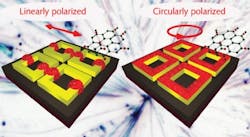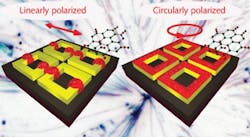Circularly polarized light optically detects individual molecules
Katholieke Universiteit Leuven (KU Leuven; Flanders, Belgium) researcher Ventsislav Valev and an international team of colleagues have developed a new method for manipulating light at the nanoscale in order to optically detect single molecules. By shining circularly polarized light on a gold, square-ring shaped nanostructure, the researchers were able to âactivateâ the entire surface of the nanostructure, thereby significantly increasing the opportunity for interaction with molecules. The work could assist in advancing technologies for visualizing single molecules and multiple-molecule interactions.
Nanotechnology researchers around the world are exploring ways to optically detect single molecules; however, single molecules have extremely weak optical responses, hindering progress. So far, scientists have developed a way to use metal nanostructures to focus light into tiny spots called âhotspots,' which excite electrons on the surface of the nanostructure, causing them to oscillate coherently. When shone on a molecule, and with the help of these oscillating electrons, the focused light can increase a moleculeâs optical signal to 100 billion times its normal strength. This signal can then be detected with an optical microscope.
But hotspots can become too hot, and they are just spots: The heat from hotspots can melt the nanostructures, thus destroying their ability to channel light effectively, and hotspots produce only a very small cross-section in which interaction with molecules can take place. Additionally, for a single molecule to become detectable, it needs to find the hotspot.
In order to overcome these limitations, Valev and his colleagues sought out to nanoengineer larger spots. They began by shining circularly polarized light rather than linearly polarized light on the nanostructures and found that this could increase the useful area of these nanostructures. More importantly, when shone on square-ring shaped gold nanostructures, the scientists observed that the entire surface of the nanostructures was successfully activated.
âEssentially, light is constituted of electric and magnetic fields moving through space. While with linearly polarized light, the fields move in a linear, forward direction, with circularly polarized light, they rotate in a spiral-like motion," explains Valev. The circularly polarized light imparts a sense of rotation on the electron density in ring-shaped gold nanostructures, thus trapping the light in the rings and forming âloops of light.' The loops of light cause excited electrons to oscillate coherently on the full surface of the square-ringed nanostructures--rather than in a few concentrated hotspots. This increases the opportunity for interaction with molecules: âThe trick is to try to activate the whole surface of the nanostructure so that whenever a molecule attaches, we will be able to see it,â says Dr. Valev. âThat is precisely what we did.â
The findings were published in Advanced Materials: http://onlinelibrary.wiley.com/doi/10.1002/adma.201201151/abstract.
-----
Follow us on Twitter, 'like' us on Facebook, and join our group on LinkedIn
Laser Focus World has gone mobile: Get all of the mobile-friendly options here.
Subscribe now to BioOptics World magazine; it's free!

